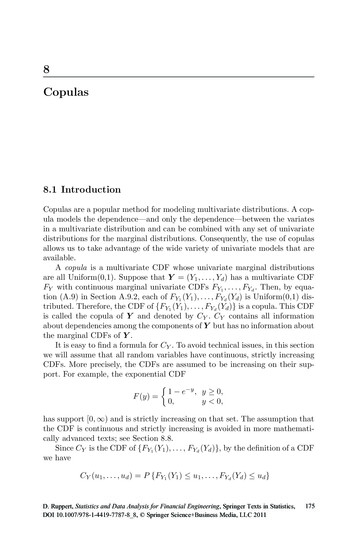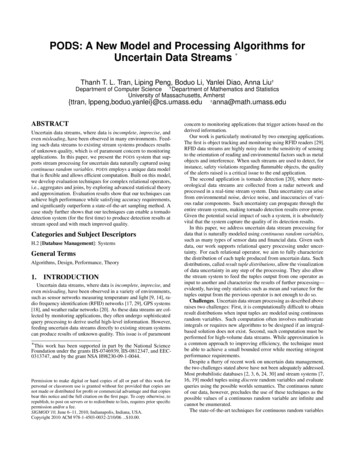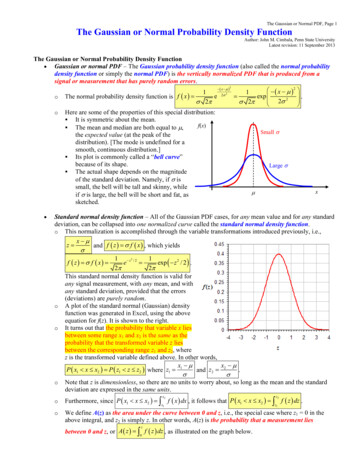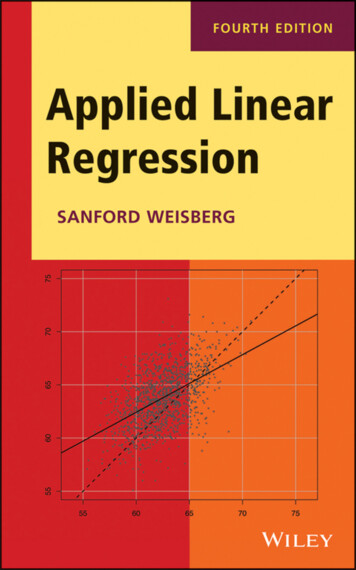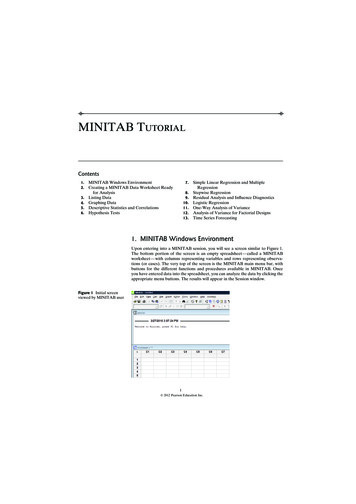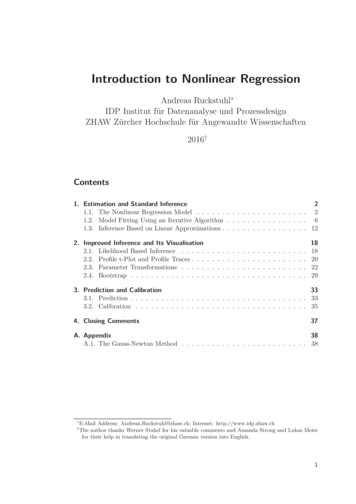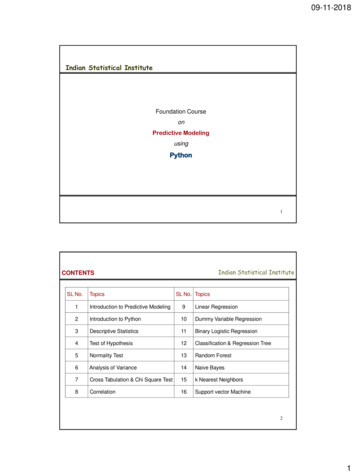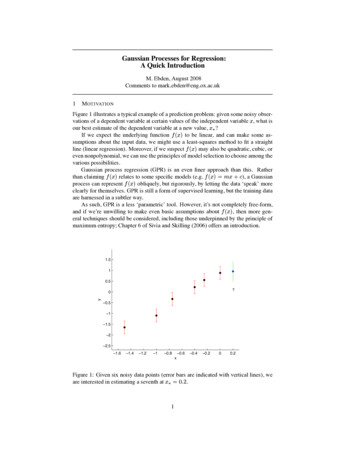
Transcription
Gaussian Processes for Regression:A Quick IntroductionM. Ebden, August 2008Comments to mark.ebden@eng.ox.ac.uk1M OTIVATIONFigure 1 illustrates a typical example of a prediction problem: given some noisy observations of a dependent variable at certain values of the independent variable , what isour best estimate of the dependent variable at a new value, ?If we expect the underlying functionto be linear, and can make some assumptions about the input data, we might use a least-squares method to fit a straightline (linear regression). Moreover, if we suspectmay also be quadratic, cubic, oreven nonpolynomial, we can use the principles of model selection to choose among thevarious possibilities.Gaussian process regression (GPR) is an even finer approach than this. Ratherthan claimingrelates to some specific models (e.g.), a Gaussianprocess can representobliquely, but rigorously, by letting the data ‘speak’ moreclearly for themselves. GPR is still a form of supervised learning, but the training dataare harnessed in a subtler way.As such, GPR is a less ‘parametric’ tool. However, it’s not completely free-form,and if we’re unwilling to make even basic assumptions about, then more general techniques should be considered, including those underpinned by the principle ofmaximum entropy; Chapter 6 of Sivia and Skilling (2006) offers an introduction.1.510.5?y0 0.5 1 1.5 2 2.5 1.6 1.4 1.2 1 0.8 0.6 0.4 0.200.2xFigure 1: Given six noisy data points (error bars are indicated with vertical lines), weare interested in estimating a seventh at.1
2D EFINITION OF A G AUSSIAN P ROCESSGaussian processes (GPs) extend multivariate Gaussian distributions to infinite dimensionality. Formally, a Gaussian process generates data located throughout some domainsuch that any finite subset of the range follows a multivariate Gaussian distribution.Now, the observations in an arbitrary data set,, can always beimagined as a single point sampled from some multivariate ( -variate) Gaussian distribution, after enough thought. Hence, working backwards, this data set can be partneredwith a GP. Thus GPs are as universal as they are simple.Very often, it’s assumed that the mean of this partner GP is zero everywhere. Whatrelates one observation to another in such cases is just the covariance function,.A popular choice is the ‘squared exponential’,(1)where the maximum allowable covariance is defined as— this should be high forfunctions which cover a broad range on the axis. If, thenapproachesthis maximum, meaningis nearly perfectly correlated with. This is good:for our function to look smooth, neighbours must be alike. Now if is distant from, we have instead, i.e. the two points cannot ‘see’ each other. So, forexample, during interpolation at new values, distant observations will have negligibleeffect. How much effect this separation has will depend on the length parameter, , sothere is much flexibility built into (1).Not quite enough flexibility though: the data are often noisy as well, from measurement errors and so on. Each observation can be thought of as related to an underlyingfunctionthrough a Gaussian noise model:(2)something which should look familiar to those who’ve done regression before. Regression is the search for. Purely for simplicity of exposition in the next page, wetake the novel approach of folding the noise into, by writing(3)whereis the Kronecker delta function. (When most people use Gaussianprocesses, they keepseparate from. However, our redefinition ofis equally suitable for working with problems of the sort posed in Figure 1. So, givenobservations , our objective is to predict , not the ‘actual’ ; their expected valuesare identical according to (2), but their variances differ owing to the observational noiseprocess. e.g. in Figure 1, the expected value of , and of , is the dot at .)To prepare for GPR, we calculate the covariance function, (3), among all possiblecombinations of these points, summarizing our findings in three matrices:.(4)(5)Confirm for yourself that the diagonal elements of are, and that its extremeoff-diagonal elements tend to zero when spans a large enough domain.2
3H OW TO R EGRESS USING G AUSSIAN P ROCESSESSince the key assumption in GP modelling is that our data can be represented as asample from a multivariate Gaussian distribution, we have that(6)where indicates matrix transposition. We are of course interested in the conditionalprobability: “given the data, how likely is a certain prediction for ?”. Asexplained more slowly in the Appendix, the probability follows a Gaussian distribution:(7)Our best estimate foris the mean of this distribution:(8)and the uncertainty in our estimate is captured in its variance:(9)We’re now ready to tackle the data in Figure 1.1. There areobservations , atWe knowfrom the error bars. With judicious choices ofand (moreon this later), we have enough to calculate a covariance matrix using (4):From (5) we also have2. From (8) and (9),andand.3. Figure 1 shows a data point with a question mark underneath, representing theestimation of the dependent variable at.We can repeat the above procedure for various other points spread over some portionof the axis, as shown in Figure 2. (In fact, equivalently, we could avoid the repetitionby performing the above procedure once with suitably largerandmatrices.In this case, since there are 1,000 test points spread over the axis,would beof size 1,000 1,000.) Rather than plotting simple error bars, we’ve decided to plot, giving a 95% confidence interval.3
1.510.5y0 0.5 1 1.5 2 2.5 1.6 1.4 1.2 1 0.8 0.6 0.4 0.200.2xFigure 2: The solid line indicates an estimation of95% confidence intervals are shaded.4for 1,000 values of. PointwiseGPR IN THE R EAL WORLDThe reliability of our regression is dependent on how well we select the covariancefunction. Clearly if its parameters — call them— are not chosen sensibly, the result is nonsense. Our maximum a posteriori estimate of occurswhenis at its greatest. Bayes’ theorem tells us that, assuming we have littleprior knowledge about what should be, this corresponds to maximizing,given by(10)Simply run your favourite multivariate optimization algorithm (e.g. conjugate gradients, Nelder-Mead simplex, etc.) on this equation and you’ve found a pretty goodchoice for ; in our example,and.It’s only “pretty good” because, of course, Thomas Bayes is rolling in his grave.Why commend just one answer for , when you can integrate everything over the manydifferent possible choices for ? Chapter 5 of Rasmussen and Williams (2006) presentsthe equations necessary in this case.Finally, if you feel you’ve grasped the toy problem in Figure 2, the next two examples handle more complicated cases. Figure 3(a), in addition to a long-term downwardtrend, has some fluctuations, so we might use a more sophisticated covariance function:(11)The first term takes into account the small vicissitudes of the dependent variable, andthe second term has a longer length parameter () to represent its long-term4
(b)(a)5643421yy200 1 2 2 3 4 4 1012345 56x 10123x4567Figure 3: Estimation of (solid line) for a function with (a) short-term and long-termdynamics, and (b) long-term dynamics and a periodic element. Observations are shownas crosses.trend. Covariance functions can be grown in this way ad infinitum, to suit the complexity of your particular data.The function looks as if it might contain a periodic element, but it’s difficult to besure. Let’s consider another function, which we’re told has a periodic element. Thesolid line in Figure 3(b) was regressed with the following covariance function:(12)The first term represents the hill-like trend over the long term, and the second termgives periodicity with frequency . This is the first time we’ve encountered a casewhere and can be distant and yet still ‘see’ each other (that is,for).What if the dependent variable has other dynamics which, a priori, you expect toappear? There’s no limit to how complicatedcan be, provided is positivedefinite. Chapter 4 of Rasmussen and Williams (2006) offers a good outline of therange of covariance functions you should keep in your toolkit.“Hang on a minute,” you ask, “isn’t choosing a covariance function from a toolkita lot like choosing a model type, such as linear versus cubic — which we discussedat the outset?” Well, there are indeed similarities. In fact, there is no way to performregression without imposing at least a modicum of structure on the data set; such is thenature of generative modelling. However, it’s worth repeating that Gaussian processesdo allow the data to speak very clearly. For example, there exists excellent theoretical justification for the use of (1) in many settings (Rasmussen and Williams (2006),Section 4.3). You will still want to investigate carefully which covariance functionsare appropriate for your data set. Essentially, choosing among alternative functions isa way of reflecting various forms of prior knowledge about the physical process underinvestigation.5
5D ISCUSSIONWe’ve presented a brief outline of the mathematics of GPR, but practical implementation of the above ideas requires the solution of a few algorithmic hurdles as opposedto those of data analysis. If you aren’t a good computer programmer, then the codefor Figures 1 and 2 is at /GPtut.zip,and more general code can be found at http://www.gaussianprocess.org/gpml.We’ve merely scratched the surface of a powerful technique (MacKay, 1998). First,although the focus has been on one-dimensional inputs, it’s simple to accept those ofhigher dimension. Whereas would then change from a scalar to a vector,would remain a scalar and so the maths overall would be virtually unchanged. Second,the zero vector representing the mean of the multivariate Gaussian distribution in (6)can be replaced with functions of . Third, in addition to their use in regression, GPsare applicable to integration, global optimization, mixture-of-experts models, unsupervised learning models, and more — see Chapter 9 of Rasmussen and Williams (2006).The next tutorial will focus on their use in classification.R EFERENCESMacKay, D. (1998). In C.M. Bishop (Ed.), Neural networks and machine learning.(NATO ASI Series, Series F, Computer and Systems Sciences, Vol. 168, pp. 133166.) Dordrecht: Kluwer Academic Press.Rasmussen, C. and C. Williams (2006). Gaussian Processes for Machine Learning.MIT Press.Sivia, D. and J. Skilling (2006). Data Analysis: A Bayesian Tutorial (second ed.).Oxford Science Publications.A PPENDIXImagine a data sample taken from some multivariate Gaussian distribution with zeromean and a covariance given by matrix . Now decompose arbitrarily into twoconsecutive subvectors and — in other words, writingwould be thesame as writing(13)where , , and are the corresponding bits and pieces that make up .Interestingly, the conditional distribution of given is itself Gaussian-distributed.If the covariance matrixwere diagonal or even block diagonal, then knowingwouldn’t tell us anything about : specifically,. On the other hand, ifwere nonzero, then some matrix algebra leads us to(14)The mean,, is known as the ‘matrix of regression coefficients’, and the variance,, is the ‘Schur complement of in ’.In summary, if we know some of , we can use that to inform our estimate of whatthe rest of might be, thanks to the revealing off-diagonal elements of .6
Gaussian Processes for Classification:A Quick IntroductionM. Ebden, August 2008Prerequisite reading: Gaussian Processes for Regression1OVERVIEWAs mentioned in the previous document, GPs can be applied to problems other thanregression. For example, if the output of a GP is squashed onto the range, it canrepresent the probability of a data point belonging to one of say two types, and voilà,we can ascertain classifications. This is the subject of the current document.The big difference between GPR and GPC is how the output data, , are linked tothe underlying function outputs, . They are no longer connected simply via a noiseprocess as in (2) in the previous document, but are instead now discrete: sayprecisely for one class andfor the other. In principle, we could try fitting aGP that produces an output of approximately for some values of and approximatelyfor others, simulating this discretization. Instead, we interpose the GP between thedata and a squashing function; then, classification of a new data pointinvolves twosteps instead of one:1. Evaluate a ‘latent function’ which models qualitatively how the likelihood ofone class versus the other changes over the axis. This is the GP.2. Squash the output of this latent function ontoprob.using any sigmoidal function,Writing these two steps schematically,data,GPsigmoidlatent function,class probability,.The next section will walk you through more slowly how such a classifier operates.Section 3 explains how to train the classifier, so perhaps we’re presenting things inreverse order! Section 4 handles classification when there are more than two classes.Before we get started, a quick note on. Although other forms will do, herewe will prescribe it to be the cumulative Gaussian distribution,. This -shaped, and low into.function satisfies our needs, mapping high intoA second quick note, revisiting (6) and (7) in the first document: confirm for yourself that, if there were no noise (), the two equations could be rewritten as(1)and(2)1
2U SING THE C LASSIFIERSuppose we’ve trained a classifier from input data, , and their corresponding expertlabelled output data, . And suppose that in the process we formed some GP outputscorresponding to these data, which have some uncertainty but mean values given by. We’re now ready to input a new data point, , in the left side of our schematic, inorder to determine at the other end the probabilityof its class membership.In the first step, finding the probabilityis similar to GPR, i.e. we adapt (2):(3)(will be explained soon, but for now consider it to be very similar tosecond step, we squash to find the probability of class membership,. The expected value is.) In the(4)This is the integral of a cumulative Gaussian times a Gaussian, which can be solvedanalytically. By Section 3.9 of Rasmussen and Williams (2006), the solution is:(5)An example is depicted in Figure 1.3T RAINING THE GP IN THE C LASSIFIEROur objective now is to find and , so that we know everything about the GP producing (3), the first step of the classifier. The second step of the classifier does notrequire training as it’s a fixed sigmoidal function.Among the many GPs which could be partnered with our data set, naturally we’dlike to compare their usefulness quantitatively. Considering the outputs of a certainGP, how likely they are to be appropriate for the training data can be decomposed usingBayes’ theorem:(6)Let’s focus on the two factors in the numerator. Assuming the data set is i.i.d.,(7)Dropping the subscripts in the product,is informed by our sigmoid function,. Specifically,isby definition, and to complete the picture,. A terse way of combining these two cases is to write.The second factor in the numerator is. This is related to the output of thefirst step of our schematic drawing, but first we’re interested in the value ofwhich maximizes the posterior probability. This occurs when the derivative2
1100.980.8Latent function f(x)Predictive probability60.70.60.50.40.3420 2 4 60.2 80.10 20 10 100x1020 20 100x1020Figure 1: (a) Toy classification dataset, where circles and crosses indicate class membership of the input (training) data , at locations . is for one class andforanother, but for illustrative purposes we pretendinstead ofin this figure.The solid line is the (mean) probabilityprob, i.e. the ‘answer’ to ourproblem after successfully performing GPC. (b) The corresponding distribution of thelatent function , not constrained to lie between 0 and 1.of (6) with respect to is zero, or equivalently and more simply, when the derivativeof its logarithm is zero. Doing this, and using the same logic that produced (10) in theprevious document, we find that(8)where is the best for our problem. Unfortunately, appears on both sides of theequation, so we make an initial guess (zero is fine) and go through a few iterations. Theanswer to (8) can be used directly in (3), so we’ve found one of the two quantities weseek therein.The variance of is given by the negative second derivative of the logarithm of (6),which turns out to be, with. Making a Laplaceapproximation, we pretendis Gaussian distributed, i.e.(9)(This assumption is occasionally inaccurate, so if it yields poor classifications, better ways of characterizing the uncertainty in should be considered, for example viaexpectation propagation.)3
Now for a subtle point. The fact that can vary means that using (2) directly is inappropriate: in particular, its mean is correct but its variance no longer tells the wholestory. This is why we use the adapted version, (3), withinstead of . Since thevarying quantity in (2), , is being multiplied by, we addcovto the variance in (2). Simplification leads to (3), in which.With the GP now completely specified, we’re ready to use the classifier as describedin the previous section.GPC in the Real WorldAs with GPR, the reliability of our classification is dependent on how well we selectthe covariance function in the GP in our first step. The parameters are,one fewer now because. However, as usual, is optimized by maximizing, or (omitting on the righthand side of the equation),(10)This can be simplified, using a Laplace approximation, to yield(11)This is the equation to run your favourite optimizer on, as performed in GPR.4M ULTI -C LASS GPCWe’ve described binary classification, where the number of possible classes, , is justtwo. In the case ofclasses, one approach is to fit an for each class. In the firstof the two steps of classification, our GP values are concatenated as(12)Let be a vector of the same length as which, for each, is for the classwhich is the label and for the otherentries. Let grow to being block diagonalin the matrices. So the first change we see foris a lengtheningof the GP. Section 3.5 of Rasmussen and Williams (2006) offers hints on keeping thecomputations manageable.The second change is that the (merely one-dimensional) cumulative Gaussian distribution is no longer sufficient to describe the squashing function in our classifier;instead we use the softmax function. For the th data point,(13)where is a nonconsecutive subset of , viz. We can summarize our results with.Now that we’ve presented the two big changes needed to go from binary- to multiclass GPC, we continue as before. Setting to zero the derivative of the logarithm of thecomponents in (6), we replace (8) with(14)The corresponding variance isas before, but nowdiag,whereis amatrix obtained by stacking vertically the diagonal matricesdiag, ifis the subvector of pertaining to class .4
With these quantities estimated, we have enough to generalize (3) todiag, andwhere ,replaced with(15)represent the class-relevant information only. Finally, (11) is(16)We won’t present an example of multi-class GPC, but hopefully you get the idea.5D ISCUSSIONAs with GPR, classification can be extended to accept values with multiple dimensions, while keeping most of the mathematics unchanged. Other possible extensionsinclude using the expectation propagation method in lieu of the Laplace approximationas mentioned previously, putting confidence intervals on the classification probabilities, calculating the derivatives of (16) to aid the optimizer, or using the variationalGaussian process classifiers described in MacKay (1998), to name but four extensions.Second, we repeat the Bayesian call from the previous document to integrate overa range of possible covariance function parameters. This should be done regardlessof how much prior knowledge is available — see for example Chapter 5 of Sivia andSkilling (2006) on how to choose priors in the most opaque situations.Third, we’ve again spared you a few practical algorithmic details; computer codeis available at http://www.gaussianprocess.org/gpml, with examples.ACKNOWLEDGMENTSThanks are due to Prof Stephen Roberts and members of his Pattern Analysis ResearchGroup, as well as the ALADDIN project (www.aladdinproject.org).R EFERENCESMacKay, D. (1998). In C.M. Bishop (Ed.), Neural networks and machine learning.(NATO ASI Series, Series F, Computer and Systems Sciences, Vol. 168, pp. 133166.) Dordrecht: Kluwer Academic Press.Rasmussen, C. and C. Williams (2006). Gaussian Processes for Machine Learning.MIT Press.Sivia, D. and J. Skilling (2006). Data Analysis: A Bayesian Tutorial (second ed.).Oxford Science Publications.5
Gaussian Processes for Classification: A Quick Introduction M. Ebden, August 2008 Prerequisite reading: Gaussian Processes for Regression 1 OVERVIEW As mentioned in the previous document, GPs can be applied to problems other than
